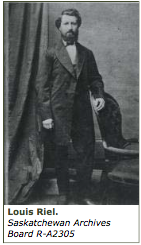
Métis patriot and martyr, founder of Manitoba, Riel was born at St. Boniface, Red River, on October 22, 1844, to Louis Riel and Julie Lagimodière. The husband of Marguerite Monet (dite Bellehumeur) and father to Jean and Angélique, he was executed for high treason at Regina, North-west Territories, on November 16, 1885. Handsome, intelligent and religious, Louis Riel seemed, even as a child, destined for greatness; from his activist father he inherited a strong sense of duty and love of community, and from his mother he acquired an intense piety. In 1858, local priests hoped to make the young Riel one of their own by sending him to the reputed Collège de Montréal; however, after the trauma of his father’s death in 1864, Riel left the college and went to work in a law firm. After a failed courtship, he returned to the Red River in 1868.
Louis Riel first came to prominence during the Red River Resistance (October 1869–May 1870): at the age of 24, educated and articulate, he arrived home in time to participate in the Métis resistance against Canada’s annexation of Rupert’s Land. Eventually, becoming president of the Métis-led Provisional Government, Riel formed partnerships with many French Métis, and used Métis boatmen and bison hunters to enforce the governing council’s will, particularly against the Canadian Party, a collection of Euro-Canadian annexationists and “loyal” French and English Métis. Riel eventually won the backing of most of the Provisional Government’s delegates by advancing a Francophone-Catholic rights agenda—as opposed to others, such as William Dease, who championed the Métis’ corporate Aboriginal rights. With the Manitoba Act, Riel and his followers provided Manitoba with bilingual public and educational institutions (Section 22); however, only Sections 31–32 dealt with the Métis’ Aboriginal rights through the individual extinguishment of their “Indian” title to the land. As a result of these provisions and the execution of Thomas Scott, an Orangeman and francophobe, by a Métis tribunal on March 4, 1870, the Red River insurgency was viewed in Ontario as a “French” rebellion rather than an Aboriginal resistance.From 1870 to 1884, Louis Riel led a restless existence. He defended Manitoba against a Fenian attack (1871); was exiled in the USA after a bounty was put on his head for Scott’s execution (1871–76, 1878–82); was elected several times to Parliament for the riding of Provencher, despite never being able to take up his seat (1873–74); and was incarcerated in insane asylums in Québec (1876–78). In the USA, Riel worked with the Republican Party, serving as a special deputy; he also taught school, and became an American citizen in 1883. Then on June 5, 1884, Riel was invited to return to the Saskatchewan District of the North-West Territories to fight once again for his peoples’ rights.
Louis Riel’s role in the 1885 uprising would have profound consequences: the socio-economic and political marginalization of the Métis; the subjugation of the plains’ First Nations; the preparation of the region for agrarian settlement; and English and French Canada’s first rift in Confederation. Through the summer of 1884, Riel tried to build consensus among the English and French Métis, Euro-Canadian settlers, and First Nations in order to address their many grievances against the federal government, including Ottawa’s failure to recognize the Métis’ land tenure, to honour First Nations’ treaties, to prevent starvation on the reserves, and to provide western Euro-Canadians with proper political representation, agricultural markets and transportation infrastructure. However, this nascent coalition dissolved due to the federal government’s divide-and-conquer strategy and to the reluctance to take up arms on the part of First Nations, Euro-Canadians and English Métis. Thus Riel and his adjutant, Gabriel Dumont, could rely on less than 300 Métis in their struggle with the Canadian state. After two brief guerrilla skirmishes at Duck Lake (March 26) and Fish Creek (April 24), and a final entrenched battle at Batoche (May 9–12), the Métis resistance ended. Riel was captured, and prepared to defend himself and the Métis cause. However, the trial was unfair: the jurors were all anglophone and Protestant, and the judge had close ties to the ruling Conservatives. Riel was sentenced to hanging despite the jury’s plea for mercy. Lucid and articulate in the defence of his sanity, Louis Riel went to the gibbet knowing that posterity would rehabilitate him and his beloved métis canadien.
Louis Riel’s legacy has been profound. No figure in Canadian history has been more analyzed, has had more differing interpretations or has been more controversial. For the Métis and for many others, Riel was a valiant leader who not only became a martyr for his people, but was also a visionary and humanitarian who saw the potential of the prairie west as a place where the world’s oppressed could live in harmony. For others, now in the minority, Riel was a mad man, a deluded prophet, an apostate and a grafter, who inflamed passions and almost tore the country asunder. In addition, Riel’s voice has been appropriated for various political ends by prairie regionalists, Québec nationalists and English Canadians, conscious of the culpability of their ancestors in his death. Recently, however, Riel has largely been viewed as a victim of English-Canadian intolerance. In 1998, for instance, an exoneration bill, Bill C-417, was introduced in Parliament before dying on the floor. The bill was a cause célèbre—a debate, which continued with the CBC’s and the Dominion Institute’s efforts to retry Riel in 2002, without Métis participation. Louis Riel will continue to haunt Canada as long as there are conflicting visions of our common past.
Darren R. Préfontaine

